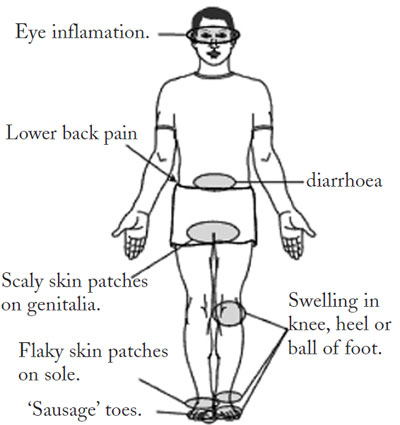 New Health Guide
New Health Guide
Males who are between 20 and 40 years of age are much more likely to get reactive arthritis. This type of arthritis can affect females as well, but mostly men get this type of inflammation. This is especially true for those who may have the human immunodeficiency virus, as reactive arthritis is caused by inflammation in the body due to an infection. After an infection has passed in the body, the joints may become inflamed. This can happen immediately after an infection, or it can take longer to happen, this all depends upon the person. There can be times in which the person feels great, and then just as quickly the inflammation flares up again and causes issues.
The main parts of reactive arthritis is swelling and pain in the joints that happens following some sort of infection in the body. Usually, it is the knees, ankles and feet that are often swelling and in pain. However, a person can find that their eyes, skin and urethra can become affected by reactive arthritis. The infections that usually trigger this arthritis to start usually occur in the intestines, urinary tract or genital area, but other infections can trigger this as well.
Many times, people refer to reactive arthritis as Reiter’s syndrome; however, this is not the proper term. Reiter’s is a type of reactive arthritis, not the arthritis itself. Luckily, those who are suffering with reactive arthritis will usually find the problem gone within 12 months. The chances of getting reactive arthritis are not high, as this is not really common.
 Once a person has an infection, usually following a sexually transmitted disease or some sort of digestive infection, they may start to see the signs of reactive arthritis a few weeks later. Reactive arthritis usually only affects:
Once a person has an infection, usually following a sexually transmitted disease or some sort of digestive infection, they may start to see the signs of reactive arthritis a few weeks later. Reactive arthritis usually only affects:
When reactive arthritis affects the joints or tendon, the symptoms are:
When reactive arthritis is seen in the eyes, the symptoms of this are:
When the urinary system shows signs of reactive arthritis, the symptoms are:
There are other symptoms of reactive arthritis that are not associated with any mentioned beforehand. For example:
If you start to see swelling in the joints or are experiencing pain in the joints, then it is best to call a doctor. This is especially true if you recently had issues with your urinary system or bouts of diarrhea.
When reactive arthritis is being discussed, there are several causes that are associated with the forming of this arthritis. These causes are:
With the causes being known, who is at risk to develop reactive arthritis? There are basically three risk factors when it comes to reactive arthritis. These are:
There is treatment for reactive arthritis, however, the treatment that a person receives really depends upon what stage their reactive arthritis is in. For those who have reactive arthritis that is just developing, then they are often given pain pills that are for anti-inflammation such as NSAID’s. Some of these are available over the counter like Naproxen. A few other examples of NSAIDs given are diclofenac, indomethacin, or celecoxib. The dosage that the person takes varies according to several factors.
When a person has been dealing with reactive arthritis for some time, then these is often referred to reactive arthritis that is in its later stages. This stage of the arthritis may not respond to NSAIDs. In most cases, the doctor has to give the patient something like an anti-rheumatic drug that is often referred to as DMARD. A few examples of this are sulfasalazine and/or methotrexate.
There are times that the arthritis will not respond to these drugs as well, which usually means the doctor recommends getting shots or cortisone into those joints that are affected with the arthritis.